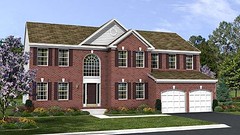It appears as if I am becoming a sociologist...
 Nikki Kahn (The Washington Post). Amani Moore chases after brother RJ in a field behind their house. "We have our own little backyard here," Toni Moore said.
Nikki Kahn (The Washington Post). Amani Moore chases after brother RJ in a field behind their house. "We have our own little backyard here," Toni Moore said.Today's Post has an article "In a Pocket of Prince William: Black Residents Find Comfort and Company in New Neighborhoods," which seems to support a hypothesis that I have, that African-Americans tend, on the whole, to favor suburban outmigration rather than a return to (or continue to live in) the city.
Note that the online photos that accompany this story are similar to the photo I used in the blog entry last week, "Commerz in the 'hood... (aka "Commerce as the engine of urbanism") ," which discussed among other things, this broad question of what I call a lag in attitude on the part of African-Americans about the desirability of urban living, using the rise of Prince George's County as a majority-African American populated wealthy county in the Washington region to illustrate the thesis.
 Hovnanian house model for a subdivision in Upper Marlboro, Maryland.
Hovnanian house model for a subdivision in Upper Marlboro, Maryland.From the article:
When Toni and Ronald Moore were relocating from Georgia to the Washington area five years ago, they looked for a place similar to suburban DeKalb County, a popular, affluent, predominantly black community outside of Atlanta.
Instead of choosing Prince George's County, the nation's wealthiest black-majority county, the Moores ended up in mostly white Prince William County. Yet they say they do not feel like outsiders. They are surrounded by other middle- and upper-middle-class blacks who have bought homes costing as much as $600,000 in new subdivisions dotting southeastern Prince William...
The Moores are part of a wave of African Americans moving to an area just off Interstate 95, south of the Potomac Mills shopping center and north of the Quantico Marine Corps Base. How this area turned into a black community almost overnight is partly a story of how hundreds of people from near and far discovered Prince William, transforming some of the county's schools, churches, stores, demographics and even its politics.
The creation of majority minority communities such as Southbridge also shows how the diversity of Washington suburbs sometimes turns up in unexpected places. There are large numbers of Koreans in Annandale, Filipinos in Manassas, Salvadorans in Langley Park, Indians in Gaithersburg and Ethiopians in South Arlington.
In urban sociology, this is explained through something called the invasion-succession theory, usually combined with the life-cycle model of neighborhood change, which until recently, posited that neighborhoods are born, age, decline (physically and socially), and eventually, die.
In the decline stage, the low cost of housing attracts people who would not otherwise be able to afford to buy or rent. (These days, because of the attraction of new residents to at least some portions of the center city, the life-cycle theory of neighborhood change is being revised to reflect that neighborhood "death" is not inevitable.)
This is why immigrants often live in center cities, because compared to the suburbs housing is cheaper. This has been a bit less true in DC, even during periods of decline, because of the presence of the federal government, which even in times where the trends for urban living were disfavorable, propped up demand enough to make the city housing stock more expensive, which is why DC tends to have more immigrant communities in the suburbs than in the city proper.
(Interestingly enough there is a new wrinkle to invasion-succession theory because by now second or third generation immigrants have moved to the suburbs, and new immigrants often end up moving directly to the suburbs to bunk-in/join the social support networks of their extended families, which are now increasingly suburban-based.)
I was joking with a Post journalist the other day that some of her colleagues need to get Neiman Fellowships and study sociology for a year at Harvard...
Contrast this story to the AP story that has been making the rounds the past few days, "College graduates seek jobs, culture in cities." From the article:
College graduates are flocking to America's big cities, chasing jobs and culture and driving up home prices. Though many of the largest cities have lost population in the past three decades, nearly all have added college graduates, an analysis by The Associated Press found.
The findings offer hope for urban areas, many of which have spent decades struggling with financial problems, job losses and high poverty rates. But they also spell trouble for some cities, especially those in the Northeast and Midwest, that have fallen behind the South and West in attracting highly educated workers.
''The largest predictor of economic well-being in cities is the percent of college graduates,'' said Ned Hill, professor of economic development at Cleveland State University. To do well, he said, cities must be attractive to educated people.

In the same conversation with the Post journalist, I commented that the tv shows Friends and Seinfeld have had a lot to do with the change in perception about the desirability of urban living. (Friends is a lot more about beautiful women living in the city, than it was about the guys. I think Jennifer Anniston's hair is a big part of it...) Compare the setting in those shows to Brady Bunch.
In any case, I think television shows targeting the African-American demographic still portray center cities as a place to escape (but I don't watch television enough to be able to assert this with my normal overflowing level of confidence). cf. Everybody Hates Chris, which has been well-reviewed.
Index Keywords: urban-revitalization



0 Comments:
Post a Comment
<< Home